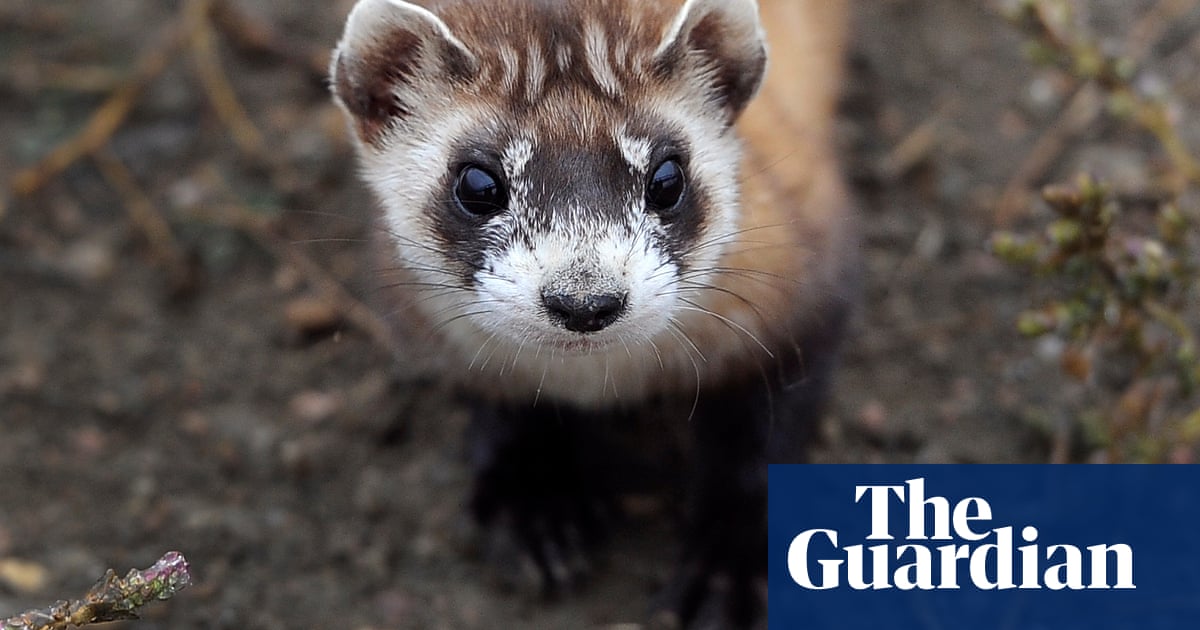States Canada and Mexico. Without ample reintroduction sites and protection from plague full black-footed ferret recovery remains difficult.
 An Invisible Enemy The Battle To Save Black Footed Ferrets From The Plague Endangered Species The Guardian
An Invisible Enemy The Battle To Save Black Footed Ferrets From The Plague Endangered Species The Guardian
This also limited overall biodiversity in the area.
Black footed ferret habitat loss. Elimination of prairie dogs in many areas has exacerbated the losses with consequent impacts on black-footed ferret that led to its imperilment and until 1981 its apparent extinction. One of the most amazing facts is a small population of black-footed ferrets was discovered in 1981. Also people wanted to get rid of them so they shot all of the prairie.
Black-footed ferrets rely on. As farmers and ranchers killed off the Prairie Dogs the ferrets were forced into a smaller and smaller area to find the remaining animals. Now numbering between 250 to 350 ferrets maintained in captivity and 300 more spread across 29 reintroduction sites in the wild all Black-footed ferrets are descendants of just those seven founders.
Black-Footed Ferrets mainly feed on Prairie Dogs which are considered pests. Several of those last 18 wild-caught Black-footed ferrets did not breed successfully. Expansion of farmland destroys many of the prairie dog burrows where these ferrets live.
They used to be a prosperous species with a population in the tens of thousand until the time came where they ended. What WWF Is Doing. The ferrets are entirely dependent on prairie colonies for shelter food and raising young.
In addition to black-footed ferrets Ferruginous hawks and Golden eagles in the state were dependent upon prairie dogs as prey also hence their decline with aggressive attempts. The Black-footed ferret population fell drastically in the earlier half of the 20th century mainly due to habitat loss. Over the last 100 years prairie dog colonies across the West have been plowed and poisoned across vast areas.
Then in the mid-1900s the species main prey the Prairie Dog was systematically poisoned to reduce damage to agricultural land. Currently habitat loss and introduced disease are key threats to this species. In 1986 all of these ferrets were completely wiped out except for the ones in captivity because of the prairie dog shortage.
More than 95 of the historic prairie dog range has been lost. Black-footed ferrets arent out of the woods yet. They still face threats from habitat loss and sylvatic plague and other diseases but hardworking conservationists have managed to save them from.
By the time the United States Fish and Wildlife Service adopted a recovery plan for habitat protection in 1978 however the ferret had declined to near extinction. Non-native disease sylvatic plague Yersinia pestis. Habitat loss and non-native disease threaten the recovery of the black-footed ferret.
The near extinction of black-footed ferrets was a direct result of the range-wide decline of their primary prey itemprairie dogs Cynomys spp Prairie dog conservation remains the primary challenge in black-footed ferret recovery. Over 20 generations later all Black-footed ferrets alive. In fact only seven became founders of todays population.
By 1986 they were completely gone from the wild. The black- footed ferret is one of North Americas most endangered species. Hier sollte eine Beschreibung angezeigt werden diese Seite lässt dies jedoch nicht zu.
As of 2013 black-footed ferrets have been reintroduced to 20 locations within their former range in eight US. During the first half of the 20th century the Black-footed Ferret population plummeted primarily as a result of habitat loss. Without sustainable populations of their main food source prairie dogs black-footed ferrets cannot survive.
The black-footed ferret is the focus of major conservation efforts on the ground today due to its endangered status. The habitat of a ferret is key to surviving in the wild. Habitat loss is another reason why the population of the black-footed ferret has fallen so low.
The range-wide loss of prairie dogs and by extension the black-footed ferret is attributable to. Loss of habitat and habitat. Loss of prey.
Black-footed ferrets once lived on black-tailed prairie dog colonies across the Great Plains from southern Canada to northern Mexico and on white-tailed and Gunnisons prairie dog colonies across the Intermountain West. Prairie dogs which are the ferrets main food have been reduced in number due to habitat loss large-scale poisoning efforts and disease. The recovery plan has since been modified.
The black-footed ferret was first officially recognized by the United States government as threatened in 1967 and was listed as endangered when the Endangered Species Act ESA was created in 1973. The prairie dogs spread a disease that caused many of them to die. Prairie dogs are keystone species in the western grasslands which means that other grassland species have an important component of their life cycle occurring in prairie dog towns.
The ferret is entirely dependent on the presence of prairie dogs and their colonies for food shelter and raising young. The black-footed ferret mainly lives in many prairie dog holes all over the United States of America. Prairie dogs have been killed because they eat grass used by livestock or winter wheat grown as a crop.
Ferret numbers declined as a result of prairie conversion to agricultural and livestock use. Because of their obligate-dependence on prairie dogs black-footed ferrets are extremely vulnerable to prairie dog habitat loss.